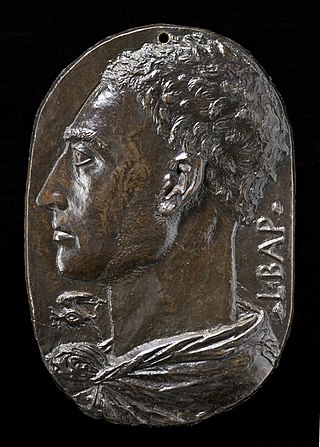
Leon Battista Alberti was an Italian Renaissance humanist author, artist, architect, poet, priest, linguist, philosopher, and cryptographer; he epitomised the nature of those identified now as polymaths. He is considered the founder of Western cryptography, a claim he shares with Johannes Trithemius.

The Zárate–Brazo Largo Bridges are two cable-stayed road and railway bridges in Argentina, crossing the Paraná River between the cities of Zárate, Buenos Aires Province, and Brazo Largo, Entre Ríos Province.
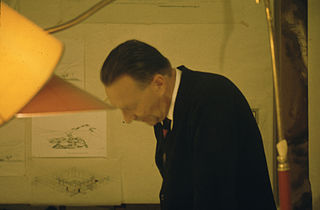
Riccardo Morandi was an Italian civil engineer best known for his innovative use of reinforced concrete and prestressed concrete, although over the years some of his particular cable-stayed bridges have had some maintenance trouble.

The Badia a Settimo or Abbazia dei Santi Salvatore e Lorenzo a Settimo is a Cluniac Benedictine abbey in the comune of Scandicci, near Florence in Tuscany, Italy. It was founded in 1004.

The Rande Bridge is a cable-stayed bridge 9 kilometres from the city of Vigo and 18 kilometres from the city of Pontevedra, in the Province of Pontevedra, Spain. It spans Vigo bay across the Rande Strait, linking the municipalities of Redondela and Moaña.

Piazza della Repubblica is a city square in Florence, Italy. It was originally the site of the city's forum; then of its old ghetto, which was swept away during the improvement works, or Risanamento, initiated during the brief period when Florence was the capital of a reunited Italy—work that also created the city's avenues and boulevards. At that time, the Loggia del Pesce from the Mercato Vecchio was also moved to Piazza Ciompi. The square's Giubbe Rosse cafe has long been a meeting place for famous artists and writers, notably those of Futurism.

Fabrizio de Miranda was an Italian bridges and structural engineer and university professor.

The Ponte alla Carraia is a five-arched bridge spanning the River Arno and linking the district of Oltrarno to the rest of the city of Florence, Italy. To the west is a weir, the Pescaia di Santa Rosa, and the Ponte Amerigo Vespucci, and to the east is the Ponte Santa Trinita. The piazzas on either bank are the Piazza Nazario Sauro (south) and the Piazza Carlo Goldoni (north). At the northernmost column of the bridge a family of coypus live in a dam.
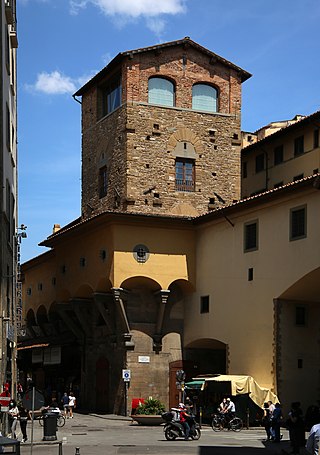
The Torre dei Mannelli is a small tower on the southeast corner of the Ponte Vecchio bridge in Florence, Italy. It is the only survivor of the four towers that once defended each corner of the bridge. In 1565, the Mannelli family refused to have it altered or demolished so that the Vasari Corridor could be built in a straight line. Instead the corridor swerved round it on brackets.

Carlo Ponti was a Swiss-born optician and photographer active in Venice from about 1848.

The Tower or Torre dei Rossi-Cerchi is a reconstructed medieval tower, now part of the B&B Hotel Pitti Palace al Ponte Vecchio, located on Via Guicciardini, corner Borgo San Jacopo, in the Oltrarno district near the entrance to the Ponte Vecchio in Florence, region of Tuscany, Italy.
The following is a timeline of the history of the city of Florence, Tuscany, Italy.
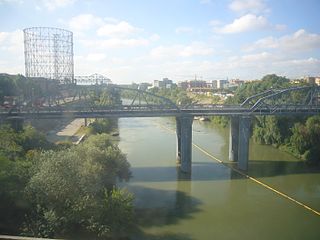
Ponte dell'Industria, also known as Ponte di ferro, is a bridge that connects via del Porto Fluviale to via Antonio Pacinotti, in Rome, in the neighborhoods Ostiense and Portuense.
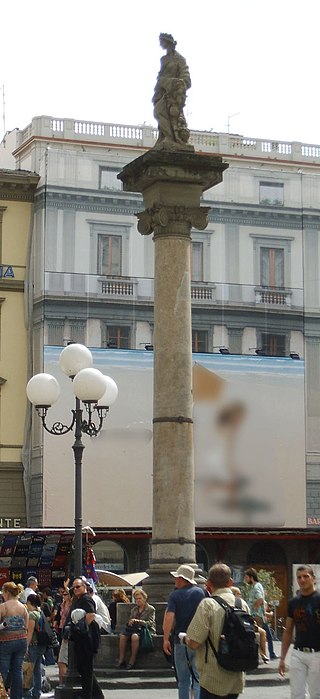
The Colonna dell'Abbondanza is a monumental column located in the Piazza della Repubblica in Florence, region of Tuscany, Italy.

The Monument to Carlo Goldoni is a white marble outdoor statue inaugurated in 1873 to commemorate the Venetian dramatist. The monument is located in a piazza of the same name, formerly called Piazza delle Travi, in front of Ponte alla Carraia, in the quartiere of Santa Maria Novella of Florence, region of Tuscany, Italy. The name of the piazza, which had reflected a postern leading to a port in the Arno River for wood barges, was renamed in 1907 on the 200th anniversary of Goldoni's birth.

Monastero delle Murate is a former Benedictine convent on Via Ghibellina in Florence, Italy.

Ponte Morandi, officially Viadotto Polcevera, was a road viaduct in Genoa, Liguria, Italy, constructed between 1963 and 1967 along the A10 motorway over the Polcevera River, from which it derived its official name. It connected Genoa's Sampierdarena and Cornigliano districts across the Polcevera Valley. The bridge was widely called "Ponte Morandi" after its structural designer, engineer Riccardo Morandi.

Ponte Flaminio is a bridge in Rome (Italy), crossed by Corso di Francia, in the Quartieri Parioli and Tor di Quinto and in the zone of Vigna Clara.
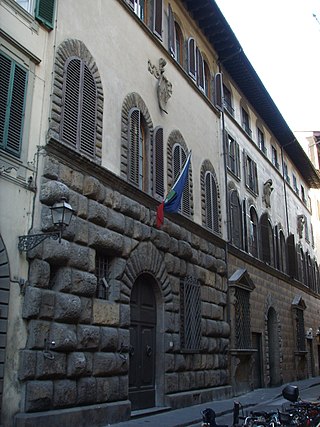
Palazzo Neroni is a historic building in the centre of Florence, located at via de' Ginori 7, with a rear entrance also at via della Stufa 4r-6r.























